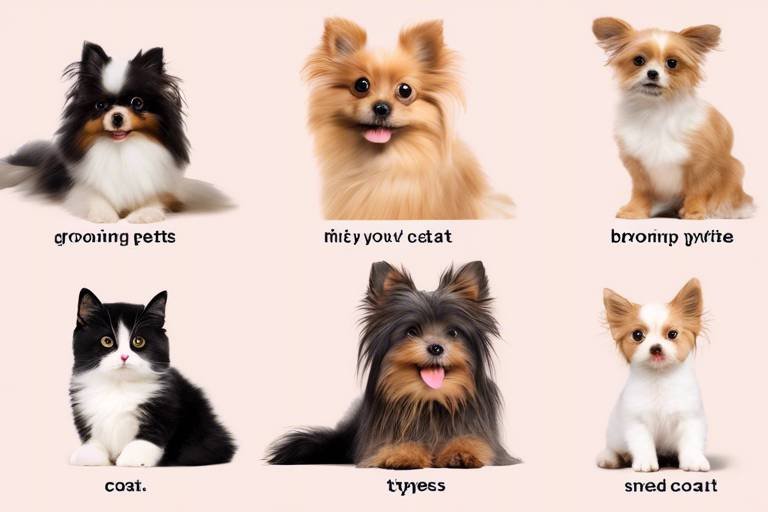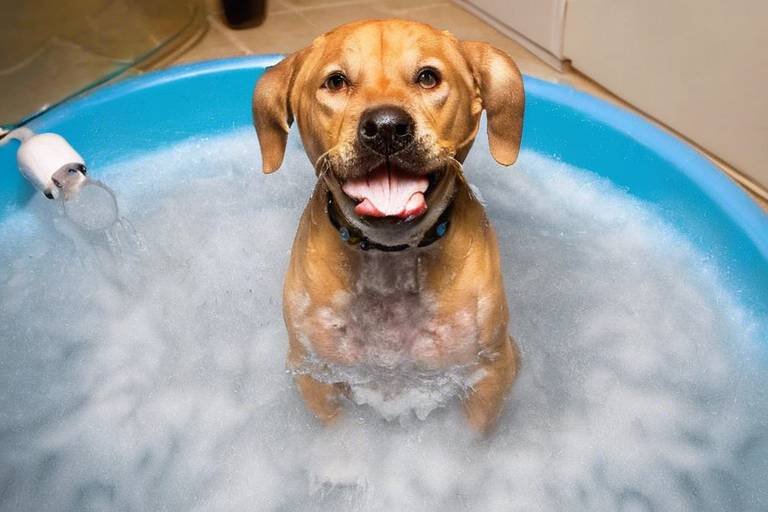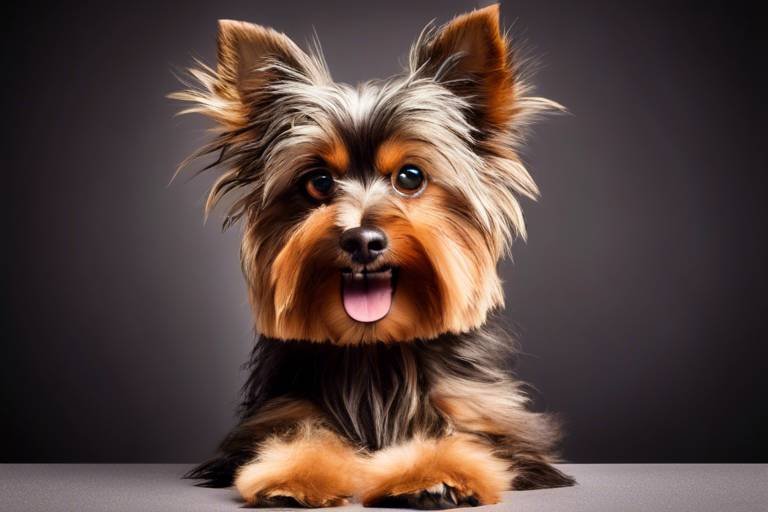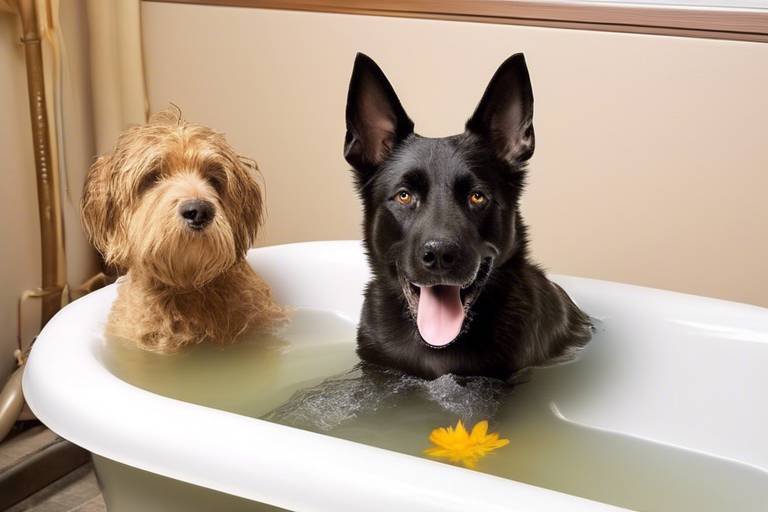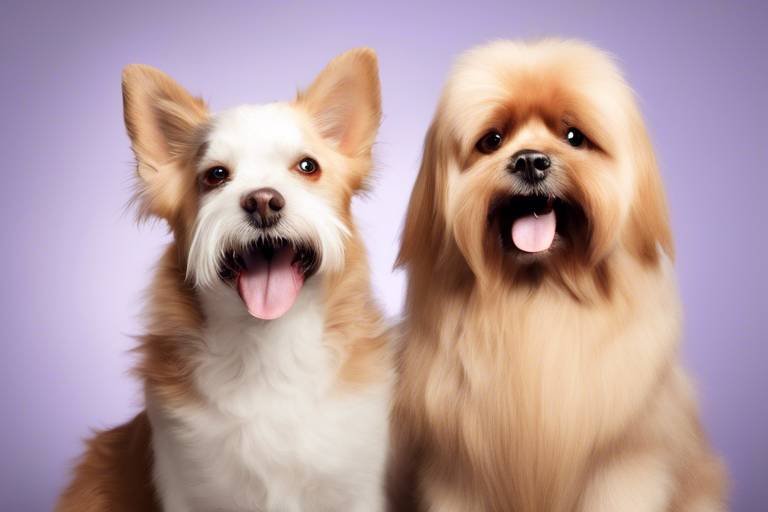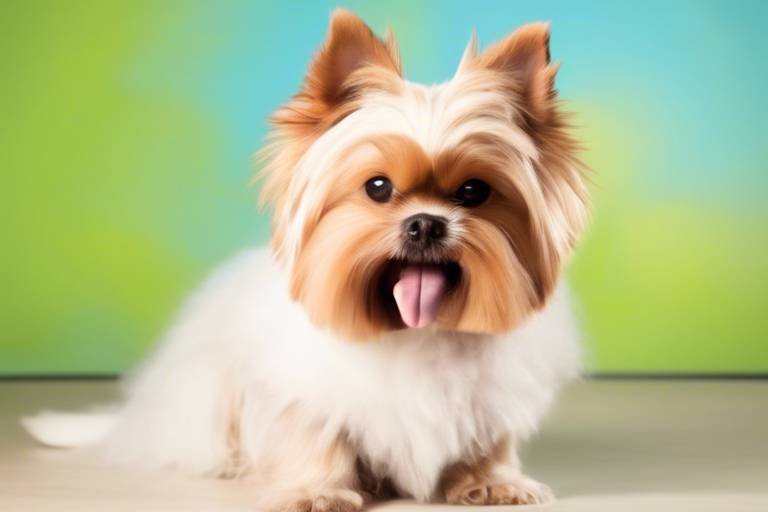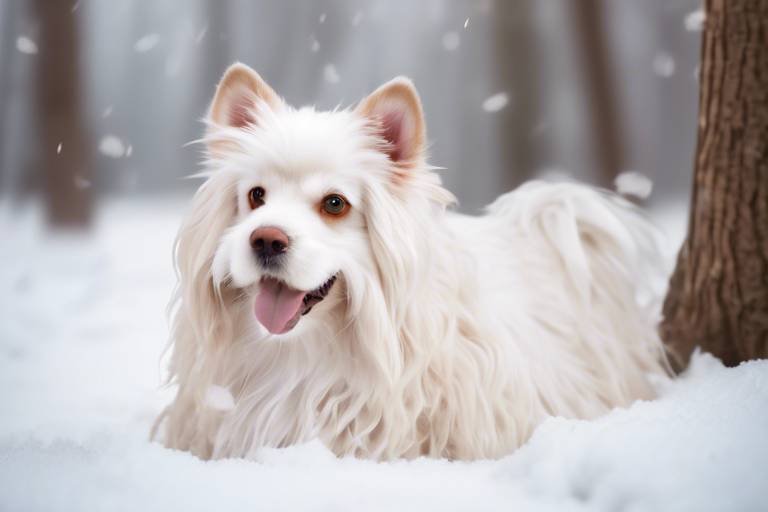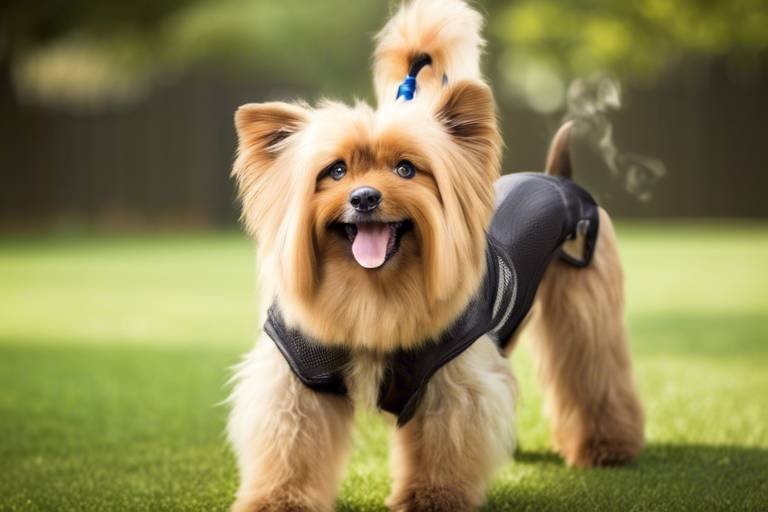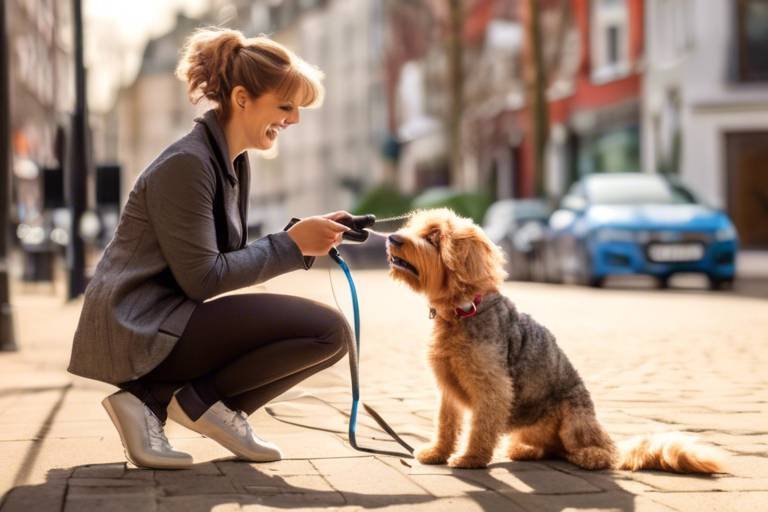How to Use Essential Oils Safely for Pet Grooming
When it comes to grooming our furry companions, we all want the best for them. But have you ever considered the potential of essential oils? These concentrated plant extracts not only smell divine but can also enhance your pet's grooming experience in several ways. However, using essential oils safely is crucial to ensure your pet's well-being. In this article, we’ll explore the ins and outs of incorporating essential oils into your pet grooming routine, the benefits they offer, and most importantly, how to use them safely.
Essential oils are derived from various parts of plants, including leaves, flowers, and roots, and are known for their aromatic properties. The process of extracting these oils typically involves methods like steam distillation or cold pressing, resulting in a highly concentrated product that captures the essence of the plant. Their popularity in grooming and wellness for pets stems from their natural properties, which can help alleviate stress, promote skin health, and even deter pests. However, with great power comes great responsibility, and understanding how to use these oils safely is essential.
Incorporating essential oils into your pet's grooming routine can offer a plethora of benefits. From calming effects to promoting skin and coat health, these oils can transform an ordinary grooming session into a holistic experience. For instance, certain oils can help calm anxious pets during grooming, while others can enhance the health of their fur. Here are some of the most notable advantages:
- Calming Effects: Some essential oils have properties that can soothe anxiety and stress in pets.
- Skin Health: Many oils can promote a healthy coat and soothe skin irritations.
- Pest Deterrence: Certain essential oils can help keep pesky bugs at bay.
Many pet owners know the struggle of grooming a nervous pet. Luckily, certain essential oils can help create a more relaxed atmosphere. For example, lavender and chamomile oils are renowned for their calming properties. By incorporating these oils into your grooming routine, you can help ease your pet’s anxiety and turn a stressful experience into a tranquil one.
Lavender oil is one of the most popular essential oils for promoting relaxation. Its soothing aroma can help calm anxious pets, making it an excellent addition to grooming sessions. You can use lavender oil by diluting it with a carrier oil and gently massaging it into your pet's coat or adding a few drops to their bath water. Just remember, a little goes a long way!
Chamomile oil is another fantastic option for helping pets relax. Known for its anti-inflammatory properties, it can also soothe skin irritations. When used during grooming, chamomile oil can create a peaceful experience for your pet. Similar to lavender, it should be diluted properly before application to ensure safety.
Essential oils can also play a significant role in maintaining your pet's skin and coat health. Oils like tea tree and coconut oil are known for their nourishing properties. These oils can help moisturize dry skin, enhance coat shine, and even combat certain skin issues. When applying these oils, be sure to use them in moderation and always dilute them properly to avoid any adverse reactions.
While essential oils can be beneficial, they must be used with caution. Not all essential oils are safe for pets, and some can even be toxic. It’s crucial to do your research and choose pet-safe oils. Always consult with your veterinarian before introducing any new products into your pet’s grooming routine.
When selecting essential oils for your pet, it’s essential to choose those that are non-toxic and safe. Some oils to avoid include:
- Tea Tree Oil
- Peppermint Oil
- Cinnamon Oil
- Clove Oil
Instead, consider using oils like lavender, chamomile, and frankincense, which are generally regarded as safe for pets when properly diluted.
Dilution is critical when using essential oils on pets. Essential oils are highly concentrated and can cause skin irritation or other adverse reactions if used undiluted. A general rule of thumb is to dilute essential oils with a carrier oil, such as coconut or almond oil, at a ratio of about 1 drop of essential oil to 1 tablespoon of carrier oil. This ensures safe application while still providing the benefits of the oils.
There are various ways to apply essential oils during grooming, each with its own benefits. Topical application involves applying diluted oils directly to your pet's coat, which can help with skin issues and enhance their grooming experience. Alternatively, diffusing essential oils can create a calming environment during grooming sessions. Just be sure to monitor your pet for any signs of discomfort or adverse reactions.
Topical application is a straightforward method for using essential oils. After diluting the oil, you can gently massage it into your pet's coat, focusing on areas that may need extra care. This method not only helps with skin health but also allows your pet to benefit from the aromatic properties of the oils.
Diffusing essential oils can also be beneficial during grooming. By using a diffuser, you can create a calming atmosphere that helps ease your pet's anxiety. Just ensure that the room is well-ventilated and that your pet has the option to leave the area if they feel overwhelmed.
Q: Are essential oils safe for all pets?
A: No, not all essential oils are safe for every type of pet. Always consult with your veterinarian before using essential oils on your pet.
Q: How can I tell if my pet is having a reaction to an essential oil?
A: Watch for signs such as excessive scratching, redness, or any unusual behavior. If you notice any of these symptoms, discontinue use immediately and consult your vet.
Q: Can I use essential oils on my pet's skin directly?
A: It’s essential to dilute essential oils with a carrier oil before applying them to your pet’s skin to avoid irritation.

Understanding Essential Oils
Essential oils are not just a trendy addition to your home; they are concentrated plant extracts that have been used for centuries in various cultures for their aromatic and therapeutic properties. These oils are derived from different parts of plants, including leaves, flowers, stems, and roots, through processes like steam distillation or cold pressing. The result is a potent liquid that captures the essence and benefits of the plant, making essential oils a popular choice in grooming and wellness routines for pets.
The reason essential oils have gained traction in the pet grooming world is due to their multifaceted benefits. They aren't just about pleasant scents; they can promote relaxation, enhance skin health, and even repel pests. Imagine walking into a grooming session where your furry friend is not only pampered but also enveloped in soothing aromas that help reduce their anxiety. Sounds delightful, right?
However, it’s essential to remember that not all essential oils are created equal. Some oils can be harmful to pets, so understanding which oils are safe is crucial. For instance, oils like lavender and chamomile are often considered pet-friendly and can be safely integrated into grooming practices. On the other hand, oils like tea tree and eucalyptus can be toxic to animals, leading to adverse reactions. This highlights the importance of doing thorough research before incorporating any essential oil into your pet’s grooming routine.
In summary, essential oils are powerful tools that can enhance your pet's grooming experience, but they come with a responsibility. By understanding their origins, benefits, and the proper ways to use them, you can ensure that grooming is not only a time for cleanliness but also a moment of relaxation and bonding for you and your furry companion.

Benefits of Essential Oils for Pets
Essential oils have gained popularity not just for their delightful aromas, but also for their incredible benefits in the realm of pet grooming. Just like humans, our furry friends can experience stress, skin issues, and even pesky pests that can disrupt their comfort. The good news? Essential oils can be a game-changer! By incorporating these concentrated plant extracts into your pet's grooming routine, you can enhance their well-being in various ways.
One of the most sought-after benefits of essential oils is their ability to promote calmness and reduce anxiety in pets. Imagine your anxious pup, trembling at the sound of thunder or the doorbell. Certain essential oils, such as lavender and chamomile, can create a serene environment, helping to soothe their nerves. When used correctly, these oils can transform a stressful grooming session into a peaceful and enjoyable experience.
Moreover, essential oils can significantly contribute to skin and coat health. Just like our skin, pets can suffer from dryness, irritation, and even allergies. Oils such as tea tree and coconut oil can hydrate and nourish their skin, promoting a shiny, healthy coat. When you apply these oils during grooming, not only do you pamper your pet, but you also provide them with the nutrients they need for optimal skin health. It’s like giving them a spa day right at home!
Additionally, essential oils can act as natural pest deterrents. Who wouldn't want to keep those pesky fleas and ticks at bay without resorting to harsh chemicals? Oils like citronella and peppermint can help repel unwanted insects, ensuring your pet stays comfortable and itch-free. This can be especially beneficial during the warmer months when pests are more prevalent. Just imagine how much happier your pet will be without the constant annoyance of bugs!
In summary, the benefits of essential oils for pets are vast and varied. They can help create a calming atmosphere, support skin and coat health, and even keep pesky pests away. However, it’s essential to remember that not all essential oils are safe for pets, so always do your research and consult with a veterinarian before diving into the world of aromatherapy for your furry companions. This way, you can enjoy the perks of essential oils while keeping your pets safe and happy!
- Are all essential oils safe for pets? No, not all essential oils are safe. It's crucial to research and choose pet-safe oils.
- How should I dilute essential oils for my pet? Always dilute essential oils with a carrier oil, such as coconut or olive oil, before applying them to your pet's skin.
- Can I use essential oils in a diffuser around my pets? Yes, but ensure the room is well-ventilated and monitor your pet for any adverse reactions.
- What should I do if my pet has a reaction to an essential oil? If you notice any signs of irritation or distress, discontinue use immediately and consult a veterinarian.
Calming Effects
Have you ever noticed your furry friend getting a bit anxious during grooming sessions? Just like humans, pets can experience stress and anxiety, and this is where the magic of essential oils comes into play. Certain essential oils have been known to possess calming properties that can help soothe your pet's nerves. Imagine how comforting it is for your dog or cat to feel relaxed while getting groomed, making the experience much more enjoyable for both of you!
Essential oils like lavender and chamomile are particularly famous for their ability to promote relaxation. When used correctly, these oils can transform a potentially stressful grooming session into a peaceful and serene experience. For instance, lavender oil is often referred to as the "universal oil" due to its versatile calming effects. Just a few drops can create an atmosphere of tranquility, which is especially beneficial for pets that may be skittish around grooming tools or unfamiliar environments.
So, how do you incorporate these soothing oils into your grooming routine? One effective method is to create a calming blend. You can mix a few drops of essential oil with a carrier oil, such as coconut or jojoba oil, and gently massage it into your pet's coat. This not only helps in reducing stress but also provides a delightful aroma that can make grooming feel like a pampering session. It's a win-win!
Here’s a quick overview of some essential oils and their calming effects:
| Essential Oil | Calming Properties | Usage Tips |
|---|---|---|
| Lavender Oil | Reduces anxiety and promotes relaxation | Mix with carrier oil for topical application |
| Chamomile Oil | Soothes nervousness and agitation | Add to a diffuser or mix with shampoo |
However, it’s crucial to remember that not all pets respond the same way to essential oils. Some may find certain scents overwhelming, while others may thrive on them. Always observe your pet's behavior when introducing a new essential oil into their grooming routine. If they seem uncomfortable or agitated, it might be best to try a different oil or consult with your veterinarian for advice.
In conclusion, using essential oils with calming effects can greatly enhance your pet's grooming experience. By creating a soothing environment and incorporating these natural remedies, you can help your furry friend feel more at ease. Just think of it as a spa day for your pet—who wouldn’t love that?
- Are all essential oils safe for pets? No, not all essential oils are safe. It's important to research and choose pet-safe oils.
- How do I know if my pet is reacting negatively to an essential oil? Watch for signs of discomfort, such as excessive drooling, sneezing, or agitation. If you notice any of these signs, discontinue use immediately.
- Can I use essential oils on all types of pets? While many essential oils are safe for dogs and cats, always consult your veterinarian before using them on other pets, such as birds or reptiles.
Lavender Oil
is often hailed as the superstar of essential oils, especially when it comes to creating a calming environment for your furry companions. Its soothing aroma can transform a stressful grooming session into a serene experience. But how exactly does this magical oil work its wonders? Well, lavender oil is derived from the flowers of the lavender plant, known scientifically as Lavandula angustifolia. The extraction process involves steam distillation, which captures the essence of the plant while preserving its therapeutic properties.
When it comes to pets, lavender oil offers a plethora of benefits. For instance, it can help reduce anxiety and promote relaxation, making it an excellent addition to your pet grooming routine. Imagine your anxious pup, who usually trembles at the sight of grooming tools, suddenly feeling at ease with just a few drops of lavender oil in the air. This oil not only calms their nerves but can also help alleviate skin irritations, thanks to its anti-inflammatory properties.
To incorporate lavender oil into your pet grooming practices, consider the following methods:
- Diffusion: Using a diffuser, you can fill the room with the calming scent of lavender before starting the grooming session. Just a few drops mixed with water can create a peaceful atmosphere.
- Topical Application: For direct application, always dilute lavender oil with a carrier oil, such as coconut or jojoba oil. A safe ratio is typically one drop of lavender oil to a teaspoon of carrier oil. This mixture can then be gently massaged into your pet's coat, promoting both relaxation and skin health.
However, it’s crucial to remember that not all pets will respond the same way to lavender oil. Some may find it incredibly soothing, while others might be indifferent. Always start with a small amount and observe your pet's reaction. If they seem relaxed and happy, you’re on the right track! But if they show signs of discomfort or distress, it’s best to discontinue use and consult with a veterinarian.
In summary, lavender oil can be a fantastic ally in your pet grooming toolkit. Its ability to calm anxious pets and support skin health makes it a versatile choice. Just remember to use it wisely and always prioritize your pet's comfort and safety!
Chamomile Oil
Chamomile oil is a gentle yet powerful essential oil that has been cherished for centuries, not just for humans but also for our furry companions. Known for its calming and soothing properties, chamomile oil can be a fantastic addition to your pet grooming routine, especially for those pets who may experience anxiety during grooming sessions. Imagine the relief of your pet as they breathe in the sweet, floral aroma of chamomile, promoting a sense of peace and tranquility. This oil is derived from the flowers of the chamomile plant, which are steam distilled to extract its beneficial compounds.
When used appropriately, chamomile oil can help alleviate stress and promote relaxation in pets, making grooming a more enjoyable experience for both you and your furry friend. It can be particularly beneficial for pets who are naturally skittish or those who may have had negative experiences during grooming in the past. By incorporating chamomile oil into your grooming routine, you can help create a calming atmosphere that encourages your pet to feel safe and relaxed.
There are several ways to safely incorporate chamomile oil into your pet grooming practices:
- Dilution: Always dilute chamomile oil before applying it to your pet's skin or coat. A good rule of thumb is to mix one drop of chamomile oil with a carrier oil, such as coconut or olive oil, before application.
- Massage: Gently massaging the diluted oil into your pet's coat can enhance the bonding experience while providing the calming effects of chamomile.
- Bathing: Adding a few drops of chamomile oil to your pet's bath can create a soothing bath time experience, helping to calm their nerves while keeping their coat clean and healthy.
However, it is crucial to monitor your pet for any signs of irritation or adverse reactions. Each pet is unique, and while chamomile is generally safe, some pets may be sensitive to certain essential oils. Always consult with your veterinarian before introducing new products into your pet's grooming regimen to ensure their safety.
In summary, chamomile oil is a wonderful tool for pet owners looking to enhance their grooming routines. Its calming properties can transform a potentially stressful experience into a soothing one, helping your furry friend look and feel their best. Just remember to use it wisely and with care, ensuring a happy and healthy grooming experience for your beloved pet.
Here are some common questions pet owners have about using chamomile oil in grooming:
- Is chamomile oil safe for all pets? While chamomile oil is generally safe for most pets, it’s essential to consult with your veterinarian, especially if your pet has any pre-existing conditions or is pregnant.
- How should I apply chamomile oil to my pet? Always dilute chamomile oil with a carrier oil before applying it to your pet’s skin or coat. You can also use it in their bath or as part of a calming massage.
- Can chamomile oil help with my pet's anxiety? Yes, chamomile oil is known for its calming effects and can help reduce anxiety in pets, making grooming and other stressful situations more manageable.
Skin and Coat Health
When it comes to our furry friends, maintaining their is crucial for their overall well-being. Essential oils can play a significant role in this aspect of pet grooming, providing natural benefits that promote a shiny coat and healthy skin. Just like humans, pets can experience various skin issues, including dryness, irritation, and even allergic reactions. Using the right essential oils can help alleviate these problems and enhance their grooming routine.
One of the standout players in the world of essential oils for skin and coat health is tea tree oil. Known for its antimicrobial properties, tea tree oil can help combat skin infections and soothe irritated skin. However, it's important to use this oil with caution, as it can be potent. Always dilute it properly before applying it to your pet's skin. Another fantastic option is coconut oil, which not only moisturizes the skin but also adds a lovely shine to your pet's coat. You can use it as a conditioning treatment, applying it directly to your pet's fur and massaging it into their skin.
To give you a better understanding, here's a quick
| Essential Oil | Benefits | Usage Tips |
|---|---|---|
| Tea Tree Oil | Antimicrobial, helps with skin infections | Always dilute before use |
| Coconut Oil | Moisturizes skin, adds shine to coat | Apply directly, massage into skin |
| Frankincense Oil | Reduces inflammation, promotes healing | Use in a diffuser or diluted for topical use |
Moreover, incorporating essential oils into your pet grooming routine can be as simple as adding a few drops to their shampoo or conditioner. This not only enhances the cleansing process but also provides long-lasting benefits. Just imagine your pet enjoying a bath infused with the calming scent of lavender or the refreshing aroma of eucalyptus. It’s a sensory experience that can turn an ordinary grooming session into a delightful spa day!
However, it’s essential to remember that not all essential oils are created equal. Some can be harmful to pets, so always do your research and consult with your veterinarian before introducing new oils into your grooming regimen. By focusing on safe and beneficial essential oils, you can ensure that your pet enjoys a healthy coat and skin, making them feel good and look fabulous!

Safety Precautions
When it comes to using essential oils for pet grooming, safety should always be your top priority. While these oils can offer numerous benefits, they can also pose risks if not used correctly. Just like we wouldn't pour a bottle of perfume directly onto our skin without considering the ingredients, the same caution applies to our furry friends. Essential oils are potent and concentrated, which means that improper use can lead to adverse reactions. It’s essential to understand the potential risks and take the necessary precautions to ensure your pet's well-being.
First and foremost, it's crucial to choose pet-safe oils. Not all essential oils are suitable for animals, and some can be downright toxic. For instance, oils like tea tree, eucalyptus, and citrus oils can be harmful to pets. Always do your research and consult with a veterinarian or an animal aromatherapy expert before introducing any new oil into your grooming routine. Here’s a quick reference table of some common essential oils and their safety for pets:
| Essential Oil | Safety for Pets |
|---|---|
| Lavender | Safe |
| Chamomile | Safe |
| Tea Tree | Unsafe |
| Eucalyptus | Unsafe |
| Peppermint | Unsafe |
Once you’ve selected the right oils, the next step is to focus on proper dilution techniques. Essential oils are highly concentrated, and using them undiluted on your pet’s skin can lead to irritation or even chemical burns. A general guideline is to dilute essential oils with a carrier oil, such as coconut or jojoba oil, before application. A safe dilution ratio is typically 1 drop of essential oil to 1 tablespoon of carrier oil for most pets. However, always adjust based on your pet's size and sensitivity.
Additionally, it’s wise to conduct a patch test before fully incorporating a new essential oil into your grooming routine. Apply a small diluted amount on a small area of your pet's skin and observe for any adverse reactions over 24 hours. If you notice any signs of irritation, such as redness or swelling, discontinue use immediately. Remember, just like humans, every pet is unique, and their reactions can vary widely.
Lastly, always ensure that the area where you are grooming is well-ventilated. If you're using a diffuser, keep it in a separate room or away from your pet while they are being groomed. This helps to avoid overwhelming their sensitive noses with strong scents. Just as we sometimes need a breather from strong fragrances, our pets can also appreciate a fresh and clean environment.
In summary, while essential oils can enhance your pet grooming experience, it’s vital to approach their use with caution. By selecting safe oils, properly diluting them, conducting patch tests, and ensuring good ventilation, you can create a safe and enjoyable grooming routine for your furry companions.
Q: Can I use essential oils on my cat?
A: It's generally advised to avoid using essential oils on cats, as they are more sensitive to them than dogs. Always consult with a vet first.
Q: How do I know if an essential oil is safe for my pet?
A: Research the specific oil and consult with a veterinarian or an animal aromatherapy expert to ensure it’s safe for your pet.
Q: What should I do if my pet has a negative reaction to an essential oil?
A: Discontinue use immediately and consult your veterinarian for advice on how to treat the reaction.
Choosing Pet-Safe Oils
When it comes to using essential oils for pet grooming, one of the most critical steps is . Not all essential oils are created equal, and some can be downright harmful to our furry companions. It's essential to understand that while essential oils can offer numerous benefits, they can also pose risks if not selected wisely. For instance, oils like tea tree and eucalyptus are known to be toxic to pets, leading to a range of adverse effects, from mild irritation to severe toxicity. Therefore, it's crucial to familiarize yourself with which oils are safe and which should be avoided.
To help you navigate this aromatic landscape, here are some essential oils that are generally considered safe for pets:
- Lavender Oil - Known for its calming properties, lavender oil can help soothe anxious pets.
- Chamomile Oil - This oil is excellent for relaxation and can help ease skin irritations.
- Frankincense Oil - Often used for its anti-inflammatory properties, it can support overall skin health.
- Rosemary Oil - This oil can act as a natural pest deterrent while promoting a healthy coat.
However, it's not just about knowing which oils are safe; you also need to consider the quality of the oils. Always opt for high-quality, pure essential oils from reputable sources. Look for oils that are labeled as 100% pure and free from additives or synthetic ingredients. This ensures that you are using a product that is not only effective but also safe for your pet.
Additionally, always consult with a veterinarian before introducing any new essential oil into your pet's grooming routine. Your vet can provide personalized advice based on your pet's specific health needs and conditions. This precautionary step is vital, especially if your pet has pre-existing health issues or is pregnant, as certain oils may not be suitable for them.
In summary, choosing pet-safe oils involves a combination of knowledge about which oils are safe, understanding the quality of the oils, and consulting with a veterinarian. By taking these steps, you can confidently enhance your pet's grooming experience with the wonderful benefits of essential oils.
Proper Dilution Techniques
When it comes to using essential oils for pet grooming, are absolutely crucial. Why? Well, essential oils are highly concentrated substances, and applying them directly to your pet's skin or coat without dilution can lead to irritation or even more severe reactions. Think of essential oils like a strong cup of coffee; a little can be invigorating, but too much can leave you jittery and uncomfortable. So, let’s dive into the world of dilution and how to do it safely.
The general rule of thumb for diluting essential oils for pets is to use a carrier oil. Carrier oils are neutral oils that help dilute the potency of essential oils, making them safer for application. Some popular carrier oils include coconut oil, sweet almond oil, and jojoba oil. Each of these oils not only helps in dilution but also provides additional benefits for your pet's skin and coat.
To effectively dilute essential oils, follow these simple steps:
- Choose the Right Essential Oil: Not all essential oils are safe for pets, so make sure to select ones that are known to be pet-friendly.
- Determine the Dilution Ratio: A common dilution ratio for pets is 1 drop of essential oil per 1 tablespoon of carrier oil. This is a safe starting point for most pets.
- Mix Well: Combine the essential oil and carrier oil in a small container. Make sure to mix them thoroughly to ensure an even distribution.
- Patch Test: Before applying the diluted mixture to your pet's entire coat, do a patch test on a small area of skin to check for any adverse reactions.
Here's a quick reference table to help you understand the dilution ratios:
| Essential Oil | Carrier Oil | Dilution Ratio |
|---|---|---|
| Lavender Oil | Coconut Oil | 1 drop per 1 tablespoon |
| Chamomile Oil | Sweet Almond Oil | 1 drop per 1 tablespoon |
| Tea Tree Oil | Jojoba Oil | 1 drop per 1 tablespoon |
Remember, the goal is to create a safe and pleasant grooming experience for your furry friend. Always keep an eye on your pet after introducing any new products, and consult your veterinarian if you have any concerns. By following these dilution techniques, you can enjoy the many benefits of essential oils while keeping your pet happy and healthy!
Q: Can I use essential oils on all types of pets?
A: Not all essential oils are safe for every type of pet. Always research or consult a veterinarian before using essential oils on your specific pet.
Q: How do I know if my pet is having a reaction to an essential oil?
A: Signs of a reaction may include excessive scratching, redness, or swelling. If you notice any of these symptoms, discontinue use immediately and consult a veterinarian.
Q: How often can I use essential oils on my pet?
A: Frequency can vary, but a good rule of thumb is to use diluted essential oils no more than once a week during grooming sessions.
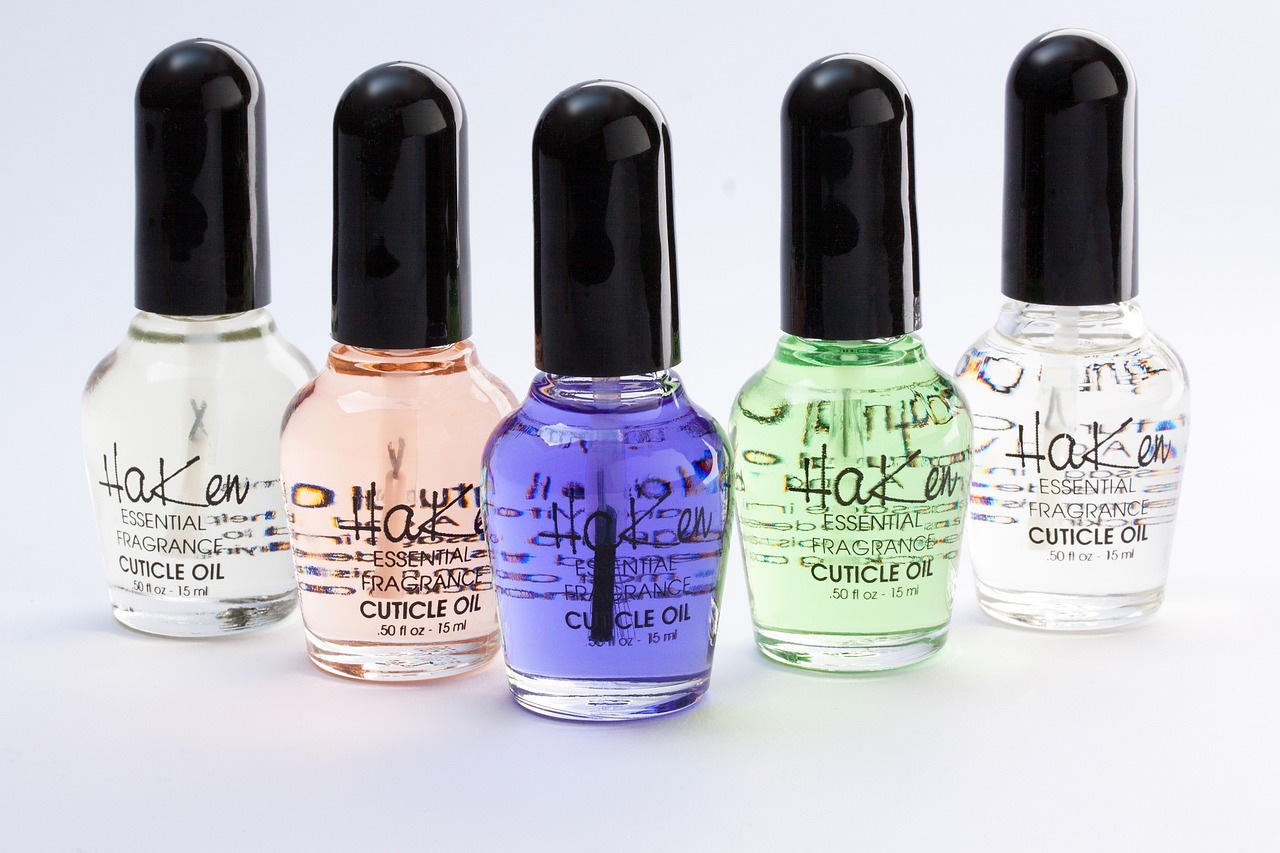
Application Methods
When it comes to using essential oils in pet grooming, the method of application can make a significant difference in both the effectiveness and safety of the oils. There are several ways to incorporate these aromatic plant extracts into your grooming routine, and each method has its own unique benefits. Understanding these methods will not only enhance your pet's grooming experience but also ensure that you are using the oils in a safe manner. Let's dive into the most effective application methods, focusing on topical application and diffusing oils.
Topical application is one of the most common methods for using essential oils during grooming. This technique involves applying the diluted oil directly onto your pet's coat or skin. However, it’s crucial to remember that pets have sensitive skin, and essential oils must always be diluted properly before application. A good rule of thumb is to mix one drop of essential oil with a carrier oil, such as coconut or olive oil, to create a safe blend. This will not only allow the oil to spread more easily but also minimize the risk of irritation.
When applying essential oils topically, focus on areas that may benefit the most, such as:
- Dry patches on the skin
- Areas prone to itching or irritation
- Along the spine for a calming effect
It's also important to perform a patch test on a small area of your pet's skin to check for any adverse reactions before applying the oil more broadly. Applying oils in a gentle, massaging motion can help promote relaxation and enhance the bond between you and your furry friend.
Diffusing essential oils is another fantastic method to create a calming atmosphere during grooming sessions. Using a diffuser allows the oils to disperse into the air, making it easier for your pet to inhale the beneficial properties without direct application on the skin. This method is particularly useful for pets that may be sensitive to touch or are anxious during grooming. When diffusing oils, it’s essential to choose a well-ventilated area and monitor your pet's reaction to ensure they are comfortable with the aroma.
Here are a few tips for effective and safe diffusing:
- Use a diffuser specifically designed for essential oils, as some household diffusers may not be suitable for pets.
- Start with a low concentration of oil and gradually increase it based on your pet's comfort level.
- Ensure that your pet has the option to leave the room if the scent becomes overwhelming.
By diffusing essential oils like lavender or chamomile, you can create a serene environment that not only calms your pet but also enhances their overall grooming experience. The gentle aroma can help mask unpleasant smells and promote a sense of tranquility, making grooming a more enjoyable ritual for both of you.
Q: Are all essential oils safe for pets?
A: No, not all essential oils are safe for pets. It's essential to research and choose pet-safe oils, such as lavender and chamomile, while avoiding oils like tea tree and eucalyptus, which can be toxic.
Q: How should I dilute essential oils for my pet?
A: A common dilution ratio is one drop of essential oil to one tablespoon of carrier oil. Always perform a patch test before widespread application.
Q: Can I use essential oils on all types of pets?
A: While many essential oils are safe for dogs and cats, it's crucial to consult with a veterinarian before introducing oils to other pets like birds, reptiles, or small mammals, as they may have different sensitivities.
Q: How do I know if my pet is having a negative reaction to an essential oil?
A: Signs of a negative reaction can include excessive scratching, lethargy, vomiting, or difficulty breathing. If you notice any of these symptoms, discontinue use immediately and consult a veterinarian.
Topical Application
When it comes to grooming your furry friend, of essential oils can be a game-changer. This method allows you to apply the oils directly onto your pet's skin and coat, providing targeted benefits that can enhance their grooming experience. However, it’s crucial to approach this technique with care and knowledge. Just like you wouldn’t slather on sunscreen without checking the ingredients, you need to ensure that the essential oils you choose are safe for your pet’s unique needs.
First and foremost, always start with a pet-safe essential oil. Some popular options include lavender, chamomile, and cedarwood, as they are known for their calming and soothing properties. Before applying any oil, it’s best to perform a patch test. This means applying a small amount of diluted oil to a tiny area of your pet's skin and observing for any adverse reactions over the next 24 hours. If your pet shows signs of irritation, such as redness or excessive scratching, it’s best to avoid that oil in the future.
Next, dilution is key. Essential oils are highly concentrated, and using them undiluted can lead to skin irritations or allergic reactions. A good rule of thumb is to dilute essential oils with a carrier oil, such as coconut or olive oil. Here’s a simple dilution guideline:
| Essential Oil | Carrier Oil | Recommended Ratio |
|---|---|---|
| Lavender Oil | Coconut Oil | 1 drop of lavender to 1 teaspoon of carrier oil |
| Chamomile Oil | Olive Oil | 1 drop of chamomile to 1 teaspoon of carrier oil |
| Cedarwood Oil | Sweet Almond Oil | 1 drop of cedarwood to 1 teaspoon of carrier oil |
Once you have your diluted mixture ready, you can apply it using your fingertips or a soft cloth. Gently massage the oil into your pet’s coat, focusing on areas where they may experience dryness or irritation. This not only helps the oil absorb better but also provides a soothing massage that your pet will likely enjoy. Just imagine how relaxing it is to have someone give you a gentle rubdown; your pet deserves that too!
While topical application can be beneficial, it’s essential to avoid certain areas. Keep essential oils away from your pet’s eyes, nose, and any open wounds. If your pet has sensitive skin or a pre-existing condition, it’s wise to consult your veterinarian before trying topical applications of essential oils. Remember, safety first!
In conclusion, topical application of essential oils can be an excellent addition to your pet grooming routine, offering benefits such as enhanced relaxation and improved skin health. Just be sure to follow the guidelines for safe use, and your furry friend will thank you for it!
- Are all essential oils safe for pets? No, not all essential oils are safe. Always research and choose pet-safe options.
- How do I know if my pet is allergic to an essential oil? Perform a patch test and watch for any signs of irritation or allergic reaction.
- Can I use essential oils on puppies or kittens? It's best to consult with a veterinarian before using essential oils on young pets.
Diffusing Oils
Diffusing essential oils is an excellent method for creating a calming atmosphere during grooming sessions for your pets. When you diffuse oils, you're not just adding a pleasant aroma to the air; you're also promoting a sense of well-being for your furry friends. Imagine your pet, usually anxious about grooming, suddenly feeling more relaxed as the soothing scent of lavender wafts through the room. It's like inviting a gentle breeze of tranquility into your home!
To get started with diffusing oils, you'll need a quality diffuser. There are various types available, including ultrasonic, nebulizing, and heat diffusers. Each of these works slightly differently, but they all serve the same purpose: to disperse the essential oils into the air. When selecting a diffuser, consider the size of the space you'll be using it in and the type of oil you plan to diffuse. For larger areas, a nebulizing diffuser might be more effective, while ultrasonic diffusers are great for smaller rooms.
When diffusing oils for pets, it's crucial to choose the right oils and to use them sparingly. Some essential oils can be overwhelming for pets, so always start with a few drops and monitor your pet's reaction. For instance, lavender and chamomile are excellent choices for creating a calming environment, while oils like peppermint or citrus can be too stimulating for some animals.
Here are a few tips to ensure safe and effective diffusing:
- Ventilation: Always ensure the room is well-ventilated. Open a window or door to allow fresh air to circulate, which can help prevent your pet from feeling overwhelmed.
- Duration: Limit the diffusing time to about 15-30 minutes, especially if your pet is new to essential oils. You can gradually increase the time as they become more accustomed to the scents.
- Distance: Place the diffuser at a distance from your pet's resting area. This helps to avoid direct exposure to the concentrated vapors, which can be too strong for their sensitive noses.
It's also important to observe your pet during and after diffusing. If they show signs of discomfort, such as excessive sneezing, coughing, or trying to leave the room, turn off the diffuser immediately. Remember, every pet is unique, and what works for one might not work for another.
Incorporating essential oils into your pet grooming routine through diffusion can transform the experience into a soothing ritual. Not only does it help your pet feel more at ease, but it also enhances the overall ambiance of your grooming space. So, why not give it a try? You might just find that your furry friend enjoys grooming time a whole lot more!
Q: Can I use any essential oil for diffusing around pets?
A: No, not all essential oils are safe for pets. Always choose pet-safe oils like lavender or chamomile and avoid oils that are known to be toxic to animals.
Q: How long should I diffuse essential oils for my pet?
A: It's best to diffuse for short periods, around 15-30 minutes, especially for pets new to essential oils. Monitor your pet's behavior and adjust accordingly.
Q: What should I do if my pet shows signs of distress while diffusing oils?
A: If your pet appears uncomfortable, turn off the diffuser immediately and ensure they have a well-ventilated space. Observe them closely and consult a veterinarian if necessary.
Frequently Asked Questions
- Can I use any essential oil on my pet?
No, not all essential oils are safe for pets. It's crucial to choose pet-safe oils such as lavender, chamomile, and cedarwood. Always do your research or consult a veterinarian before using any essential oil on your furry friend.
- How do I properly dilute essential oils for my pet?
Proper dilution is key to ensuring safety. A common guideline is to dilute essential oils with a carrier oil, like coconut or olive oil, at a ratio of 1 drop of essential oil to 1 tablespoon of carrier oil. This helps reduce the potency while still providing benefits.
- What are the benefits of using lavender oil for pets?
Lavender oil is famous for its calming effects. It can help reduce anxiety and stress in pets, making it an excellent addition to grooming sessions. Just a few drops in a diffuser or diluted in a carrier oil can create a soothing environment.
- Is it safe to diffuse essential oils around my pets?
Yes, diffusing essential oils can be safe for pets, but it's essential to choose the right oils and ensure proper ventilation. Always monitor your pet’s behavior when diffusing oils and consult with a vet if you're unsure.
- How often can I use essential oils during grooming?
It's best to use essential oils sparingly. Depending on your pet's needs, using them once a week during grooming is typically sufficient. Overuse can lead to sensitivities, so always observe your pet for any adverse reactions.
- Can essential oils help with my pet's skin issues?
Yes, certain essential oils, like chamomile and tea tree oil (in very diluted forms), can promote skin health. They can help soothe irritation and support healing. However, always consult with a vet before applying any oil directly to your pet's skin.
- What should I do if my pet has a negative reaction to an essential oil?
If your pet shows signs of a negative reaction, such as excessive drooling, vomiting, or difficulty breathing, discontinue use immediately and contact your veterinarian. It's always better to be safe and get professional advice.


